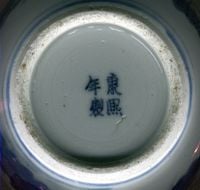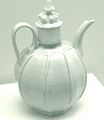Chinese ceramics
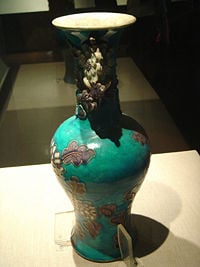
Chinese ceramics is a form of fine art developed since the dynastic periods. China has always been richly endowed with the raw materials needed for making ceramics. The first types were made about 11,000 years ago, during the Palaeolithic era. Chinese Ceramics range from construction materials such as bricks and tiles to hand-built pottery vessels fired in bonfires or kilns to the sophisticated porcelain wares made for the imperial court.
Introduction
Terminology
The Chinese term for porcelain (Chinese: 瓷, cí) covers a wide range of high-fired ceramics, some of which may not be recognized as porcelain by Western definitions. Porcelain is usually green-fired or once-fired, which means that the body and the glaze are fired together. After the body of a piece is formed and finished it is dried, coated with a glaze, dried again and fired. In the high temperature of the kiln the body and the glaze are fused together to become a unit. Chinese enamelled wares are also produced in this way, except enamels are added after the first high-temperature firing. The pieces are then fired again in a second round via a smaller, lower-temperature kiln.
Categories
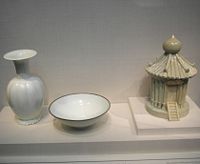
In Western tradition, ceramics are often grouped into three main categories, earthenware, stoneware and porcelain. The Chinese tradition recognises only two primary categories of ceramics, high-fired [cí 瓷] and low-fired [táo 匋] [1]. The oldest Chinese dictionaries define porcelain [cí 瓷] as "fine, compact pottery" [táo 匋] [2]. In the West the property of translucence is often regarded as a defining feature of porcelain, but this is not the case in China, where any thick or opaque piece that rings with a reasonably clear note on being struck would be regarded as porcelain [cí 瓷] [2].
Chinese ceramic wares are also classified as being either northern or southern. Present-day China comprises two separate and geologically different land masses, brought together by the action of continental drift and forming a junction that lies between the Yellow river and the Yangtze river. The contrasting geology of the north and south led to differences in the raw materials available for making ceramics.
Materials
Chinese porcelain is mainly made by the following two materials or a combination of the two. Both rocks derive from the weathering and decomposition of granitic rocks.
- China clay / (Gaoling) - composed largely of the clay mineral kaolinite.
- Chinese porcelain stone - also generically known as petunse, is a micaceous rock containing sericite and other minerals including quartz[3].
Both are composed of platy minerals consisting of small platelets that ultimately allow the material to hold large amounts of water. This is important as various methods used for forming the body parts depend on the application of compression to align the platelets. One example is throwing on a wheel to increase the plasticity and workability of the clay body.
History
Defining ceramics
In the context of Chinese ceramics the term porcelain lacks a universally accepted definition. This in turn has led to confusion about when the first Chinese porcelain was made. Claims have been made for the late Eastern Han period (100 to 200 C.E.), the Three Kingdoms period (220 to 280 C.E.), the Six Dynasties period (220 to 589 C.E.), and the Tang Dynasty (618 to 906 C.E.).
Early wares
Fragments of pottery vessels dating from around the year 9000 B.C.E. found at the Xianrendong (Spirit Cave) site, Wannian County, in the province of Jiangxi represent some of the earliest known Chinese ceramics. The wares were hand-made by coiling and fired in bonfires. Decorations include impressed cord marks, and features produced by stamping and by piercing.
The Xianrendong site was occupied from about 9000 B.C.E. to about 4000 B.C.E. During this period two types of pottery were made. The first consisted of coarse-bodied wares possibly intended for everyday use. The second being finer, thinner-bodied wares possibly intended for ritual use or special occasions. There are archaeological evidence suggesting that both types of wares were produced at the same time at some point.
Han dynasty
Some experts believe the first true porcelain was made in the province of Zhejiang during the Eastern Han period. Chinese experts emphasize the presence of a significant proportion of porcelain-building minerals (china clay, porcelain stone or a combination of both) as an important factor in defining porcelain. Shards recovered from archaeological Eastern Han kiln sites estimated firing temperature ranged from 1260 to 1300°C[4]. As far back as 1000 B.C.E., the so-called "Porcelaneous wares" or "proto-porcelain wares" were made using at least some kaolin fired at high temperatures. The dividing the line between the two and true porcelain wares is not a clear one.
Sui and Tang dynasty
During the Sui and Tang periods (581 to 906) a wide range of ceramics, low-fired and high-fired, were produced. These included the well-known Tang lead-glazed sancai (three-colour) wares, the high-firing, lime-glazed Yue celadon wares and low-fired wares from Changsha. In northern China, high-fired, translucent porcelains were made at kilns in the provinces of Henan and Hebei.
One of the first mentions of porcelain by a foreigner was made by an Arabian traveler during the Tang Dynasty who recorded that:
| “ | "They have in China a very fine clay with which they make vases which are as transparent as glass; water is seen through them. The vases are made of clay" [5]. | ” |
The Arabs were aware of the materials necessary to create glass ware, and he was certain it was not the usual glass material.
Song and Yuan dynasty
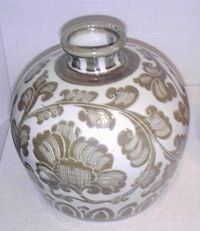
While the city of Jingdezhen has been an important production centre since the early Han Dynasty. In 1004 Jingde established the city as the main production hub for Imperial porcelain. During the Song and Yuan dynasties, porcelain made in the city and other southern China kiln sites used crushed and refined porcelain stones alone.
Qing dynasty
Two letters written by Père Francois Xavier d'Entrecolles, a Jesuit missionary and industrial spy who lived and worked in Jingdezhen in the early eighteenth century, described in detail manufacturing of porcelain in the city, see: [6]. In his first letter dating 1712, d'Entrecolles described the way in which porcelain stones were crushed, refined and formed into little white bricks, known in Chinese as petuntse. He then went on to describe the refining of china clay kaolin along with the developmental stages of glazing and firing. He explained his motives:
| “ | Nothing but my curiosity could ever have prompted me to such researches, but it appears to me that a minute description of all that concerns this kind of work might, somehow, be useful in Europe. | ” |
In 1743, during the reign of the Qianlong Emperor, Tang Ying, the imperial supervisor in the city produced a memoir entitled "Twenty illustrations of the manufacture of porcelain." Unfortunately, the original illustrations have been lost, but the text of the memoir is still accessible[7].
Jingdezhen became the main production centre for large-scale porcelain exports to Europe starting with the reign of the Wanli emperor from 1572 to 1620.
By this time china clay and porcelain stone were mixed in about equal proportions. China clay produced wares of great strength when added to the body layer. Whiteness became a much sought after property, especially when combined to form blue-and-white wares. Porcelain stone was used with lower temperature of 1250°C in the region. Compared to those mixed with china clay, which required 1350°C. The large southern egg-shaped kiln varied greatly in temperature. Near the firebox it was hot. Near the chimney, at the opposite end of the kiln, it was cooler.
Chinese porcelain wares
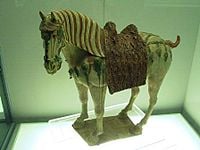
Tang Sancai burial wares
"Sancai" means three-colours. However, the colours of the glazes used to decorate the wares of the Tang dynasty were not limited to three in number. In the West, Tang sancai wares were sometimes referred to as egg-and-spinach by dealers for the use of green, yellow and white. Though the latter of the two colours might be more properly described as amber and off-white / cream.
Sancai wares were northern wares made using white and buff-firing secondary kaolins and fire clays [8]. At kiln sites located at Tongchuan, Neiqui county in Hebei and Gongxian in Henan [8], the clays used for burial wares were similar to those used by Tang potters. The burial wares were fired at a lower temperature than contemporaneous whitewares. Burial wares, such as the well-known representations of camels and horses, were cast in sections, in moulds with the parts luted together using clay slip. In some cases, a degree of individuality was imparted to the assembled figurines by hand-carving.
Jian tea wares
Jian blackwares, mainly comprising tea wares, were made at kilns located in Jianyang of Fujian province. They reached the peak of their popularity during the Song dynasty. The wares were made using locally-won, iron-rich clays and fired in an oxidising atmosphere at temperatures in the region of 1300°C. The glaze was made using clay similar to that used for forming the body, except fluxed with wood-ash. At high temperatures the molten glaze separate to produce a pattern called hare's fur. When Jian wares were set tilted for firing, drips run down the side, creating evidence of liquid glaze pooling.
The hare's fur Jian tea bowl illustrated in the Metropolitan Museum of Art in New York. It was made during the Song dynasty (960 to 1279 C.E.) and exhibits the typical pooling, or thickening, of the glaze near the bottom. The hare's fur patterning in the glaze of this bowl resulted from the random effect of phase separation during early cooling in the kiln and is unique to this bowl. No two bowls have identical patterning. The bowl also has a dark brown iron-foot which is typical of this style. It would have been fired, probably with several thousand other other pieces, each in its own stackable saggar, in a single-firing in a large dragon kiln. One such kiln, built on the side of a steep hill, was almost 150 metres in length, though most Jian dragon kilns were fewer than 100 metres in length.
An 11th century resident of Fujian wrote:
| “ | Tea is of light colour and looks best in black cups. The cups made at Jianyang are bluish-black in colour, marked like the fur of a hare. Being of rather thick fabric they retain the heat, so that when once warmed through they cool very slowly, and they are additionally valued on this account. None of the cups produced at other places can rival these. Blue and white cups are not used by those who give tea-tasting parties. [2]. | ” |
Jian tea wares of the Song dynasty were greatly appreciated and copied in Japan, where they were known as tenmoku wares. Phase separation in the iron-rich glazes of Chinese blackwares was also used to produce the well-known oil-spot, teadust and partridge-feather glaze effects.
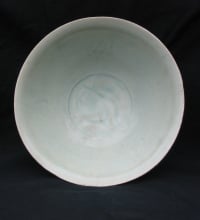
Qingbai wares
Qingbai wares were made at Jingdezhen and at many other southern kilns from the time of the Northern Song Dynasty until they were eclipsed in the 14th century by underglaze-decorated blue and white wares. Qingbai in Chinese literally means "clear white." The qingbai glaze is a porcelain glaze, so-called because it was made using porcelain stone. The qingbai glaze is clear, but contains iron in small amounts. When applied over a white porcelain body the glaze produces a greenish-blue colour that gives the glaze its name (qingbai in Chinese means greenish-blue). Some have incised or moulded decorations.
The Song dynasty qingbai bowl illustrated was likely made at the Jingdezhen village of Hutian, which was also the site of the Imperial kilns established in the year 1004. The bowl has incised decoration, possibly representing clouds or the reflection of clouds in the water. The body is white, translucent and has the texture of very-fine sugar, indicating that it was made using crushed and refined porcelain stone instead of porcelain stone and china clay. The glaze and the body of the bowl would have been fired together, in a saggar, possibly in a large wood-burning dragon-kiln or climbing-kiln, typical of southern kilns in the period.
Though many Song and Yuan qingbai bowls were fired upside down in special segmented saggars, a technique first developed at the Ding kilns in Hebei province. The rims of such wares were left unglazed but were often bound with bands of silver, copper or lead.
One remarkable example of qingbai porcelain is the so-called Fonthill Vase, described in a guide for Fonthill Abbey published in 1823
| “ | "...an oriental china bottle, superbly mounted, said to be the earliest known specimen of porcelain introduced into Europe" | ” |
The vase was made at Jingdezhen, probably around the year 1300 and was sent as a present to Pope Benedict XII by one of the last Yuan emperors of China, in 1338. The mounts referred to in the 1823 description were of enamelled silver-gilt and were added to the vase in Europe in 1381. An 18th century water colour of the vase complete with its mounts exists, but the mounts themselves were removed and lost in the 19th century. The vase is now in the National Museum of Ireland. It is often held that qingbai wares were not subject to the higher standards and regulations of the other porcelain wares, since they were made for everyday use. They were mass-produced, and received little attention from scholars and antiquarians. The Fonthill Vase, given by a Chinese emperor to a pope, might appear to cast at least some doubt on this view.
Blue and white wares
Following in the tradition of earlier qingbai porcelains, blue and white wares are glazed using a transparent porcelain glaze. The blue decoration is painted onto the body of the porcelain before glazing, using very finely ground cobalt oxide mixed with water. After the decoration has been applied the pieces are glazed and fired.
It is believed that underglaze blue and white porcelain was first made in the Tang Dynasty. Only three complete pieces of Tang blue and white porcelain are known to exist (in Singapore from Indonesian Belitung shipwreck ), but shards dating to the 8th or 9th century have been unearthed at Yangzhou in the Jiangsu province. It has been suggested that the shards originated from a kiln in the province of Henan. In 1957 excavations at the site of a pagoda in the province Zhejiang uncovered a Northern Song bowl decorated with underglaze blue and further fragments have since been discovered at the same site. In 1970 a small fragment of a blue and white bowl, again dated to the 11th century, was also excavated in the province of Zhejiang.
In 1975 shards decorated with underglaze blue were excavated at a kiln site in Jiangxi and, in the same year, an underglaze blue and white urn was excavated from a tomb dated to the year 1319, in the province of Jiangsu. It is of interest to note that a Yuan funerary urn decorated with underglaze blue and underglaze red and dated 1338 is still in the Chinese taste, even though by this time the large-scale production of blue and white porcelain in the Yuan, Mongol taste had started its influence at Jingdezhen.
Starting early in the 14th century, blue and white porcelain rapidly became the main product of Jingdezhen, reaching the height of its technical excellence during the later years of the reign of the Kangxi Emperor[9] and continuing in present times to be an important product of the city.
The tea caddy illustrated shows many of the characteristics of blue and white porcelain produced during the Kangxi period. The translucent body showing through the clear glaze is of great whiteness and the cobalt decoration, applied in many layers, has a fine blue hue. The decoration, a sage in a landscape of lakes and mountains with blazed rocks is typical of the period. The porcelain body is finely textured, indicating the presence of a significant portion of china clay in the paste. The piece would have been fired in a saggar (a lidded ceramic box intended to protect the piece from kiln debris, smoke and cinders during firing) in a reducing atmosphere in a wood-burning egg-shaped kiln, at a temperature approaching 1350°C.
Distinctive blue-and-white porcelain was exported to Japan where it is known as Tenkei blue-and-white ware or ko sometsukei. This ware is thought to have been especially ordered by tea masters for Japanese ceremony.
Fakes and reproductions
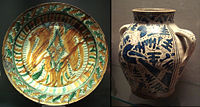
Chinese potters have a long tradition of borrowing design and decorative features from earlier wares. Whilst ceramics with features thus borrowed might sometimes pose problems of provenance, they would not generally be regarded as either reproductions or fakes. However, fakes and reproductions have also been made at many times during the long history of Chinese ceramics and continue to be made today in ever-increasing numbers.
- Reproductions of Song dynasty Longquan celadon wares were made at Jingdezhen in the early 18th century, but outright fakes were also made using special clay that were artificially aged by boiling in meat broth, refiring and storage in sewers. Père d'Entrecolles records that by this means the wares could be passed off as being hundreds of years old[6].
- At Jingdezhen the two remaining wood fired, egg-shaped kilns produce convincing reproductions of earlier wares. At Zhejiang province good reproductions of Song Longquan celedon wares continue to be made in large, side-stoked dragon kilns.
- Before World War II, the English potter Bernard Leach found what he took to be genuine Song dynasty cizhou rice-bowls being sold for very little money on the dock of a Chinese port and was surprised to learn that they were in fact newly made.[citation needed]
- In modern times the market for Song dynasty Jian tea-bowls has been severely depressed by the appearance in large numbers of modern fakes good enough to deceive even expert collectors. It is reported that some of these fakes show evidence of having had genuine Song dynasty iron-foot bases grafted onto newly made bodies.
- In the late 19th century fakes of Kangxi period famille noire wares were made that were convincing enough to deceive the experts of the day. Many such pieces may still be seen in museums today, as may pieces of genuine Kangxi porcelain decorated in the late nineteenth century with famille noire enamels. A body of modern expert opinion holds that porcelain decorated with famille noire enamels was not made at all during the Kangxi period, though this view is disputed [9].
- A fashion for Kangxi period (1662 to 1722) blue and white wares grew to large proportions in Europe during the later years of the 19th century and triggered the production at Jingdezhen of large quantities of porcelain wares that strike a resemblance to ceramics of earlier periods. Such blue and white wares were not fakes or even convincing reproductions, even though some pieces carried four-character Kangxi reign-marks that continue to cause confusion to this day. Kangxi reign-marks in the form shown in the illustration occur only on wares made towards the end of the 19th century or later, without exception.
Authentication
The most widely-known test is the thermoluminescence test, or TL test, which is used on some types of ceramic to estimate, roughly, the date of last firing. The TL test is carried out on small samples of porcelain drilled or cut from the body of a piece, which can be risky and disfiguring. For this reason, the test is rarely used for dating finely-potted, high-fired ceramics. TL testing cannot be used at all on some types of porcelain items, particularly high-fired vitreous porcelain.
See also
- Chinese art
- Blanc-de-Chine (the white wares of Dehua).
- Canton porcelain (Jingdezhen porcelain decorated at Canton for export to the West).
- Chinese export porcelain (Chinese porcelain made for export to the West).
- Dehua porcelain factories (the factories at Dehua).
- Famille jaune, noire, rose, verte (enamelled wares of the eighteenth and nineteenth centuries).
- Kraak porcelain (blue and white export wares in the Dutch taste).
- Longquan Celadon (the celadon wares of Longquan county).
- Swatow ware (wares exported through the port of Swatow).
- Yixing clay (the red stonewares of Yixing).
- Tiger Cave Kiln (site of much of Southern Song official celadon ware)
- Shiwan Ware
Gallery
Early wares
Vase, Eastern Zhou, 4th-3rd century B.C.E. British Museum.
Tang (618 to 906 C.E.)
- Changsha.JPG
Bowl, made at Changsha, Ashmolean Museum, Oxford
Song (960 to 1279 C.E.)
Ru ware stand for a wine cup, made for the imperial court. Victoria and Albert Museum, London.
Funerary vase and cover, green-glazed stoneware. Longquan, Zhejiang province, Northern Song dynasty. 10th or 11th century C.E. Collection Yuegutang, Berlin; Museum für Ostasiatische Kunst, Berlin-Dahlem.
- IMG 0307 Sng.JPG
A Longquan-ware celadon vase from the Song Dynasty
Yuan (1279 to 1368 C.E.)
Ming (1368 to 1644 C.E.)
A bodhisattva manjusri sitting atop a beast, by He Chaozong
Qing (1644 to 1912 C.E.)
- IMG 0295 Ka.JPG
Kangxi transitional porcelain, 1644-1680.
- IMG 0297 Ka .JPG
Kangxi transitional porcelain, 1644-1680.
Republic and People's Republic (1912, to date)
ReferencesISBN links support NWE through referral fees
- ↑ Pierson, Stacey, (1996). Earth, Fire and Water: Chinese Ceramic Technology. Percival David Foundation of Chinese Art, University of London. ISBN 0-7286-0265-2.
- ↑ 2.0 2.1 2.2 Bushell, S. W. (1977) Chinese Pottery and Porcelain. Oxford University Press, Kuala Lumpur. ISBN 0-19-580372-8.
- ↑ Kerr, Rose and Wood, Nigel (2004). Science and Civilisation in China, Volume 5, Part XII: Ceramic Technology. Cambridge University Press. ISBN 0-521-83833-9.
- ↑ He Li, (1996). Chinese Ceramics. The New Standard Guide. Thames and Hudson, London. ISBN 0-500-23727-1.
- ↑ Bushell, S. W. (1906). Chinese Art. Victoria and Albert Museum Art Handbook, His Majesty's Stationery Office, London.
- ↑ 6.0 6.1 Two letters written by Père Francois Xavier d'Entrecolles at Ceramics Today.com
- ↑ Tang Ying's "Twenty illustrations of the manufacture of porcelain." at the Seattle Art Museum
- ↑ 8.0 8.1 Wood, Nigel (1999). Chinese Glazes. A.C. Black, London. ISBN 0-7136-3837-0.
- ↑ 9.0 9.1 de Boulay, Anthony (1973). Chinese Porcelain. Octopus Books, London. ISBN 0-7064-0045-3
Bibilography
- Kerr, Rose and Wood, Nigel (2004). Science and Civilisation in China, Volume 5, Part XII: Ceramic Technology. Cambridge University Press. ISBN 0-521-83833-9.
- Kotz, Suzanne (ed.) (1989) Imperial Taste. Chinese Ceramics from the Percival David Foundation. Chronicle Books, San Francisco. ISBN 0-87701-612-7.
Credits
New World Encyclopedia writers and editors rewrote and completed the Wikipedia article in accordance with New World Encyclopedia standards. This article abides by terms of the Creative Commons CC-by-sa 3.0 License (CC-by-sa), which may be used and disseminated with proper attribution. Credit is due under the terms of this license that can reference both the New World Encyclopedia contributors and the selfless volunteer contributors of the Wikimedia Foundation. To cite this article click here for a list of acceptable citing formats.The history of earlier contributions by wikipedians is accessible to researchers here:
The history of this article since it was imported to New World Encyclopedia:
Note: Some restrictions may apply to use of individual images which are separately licensed.
